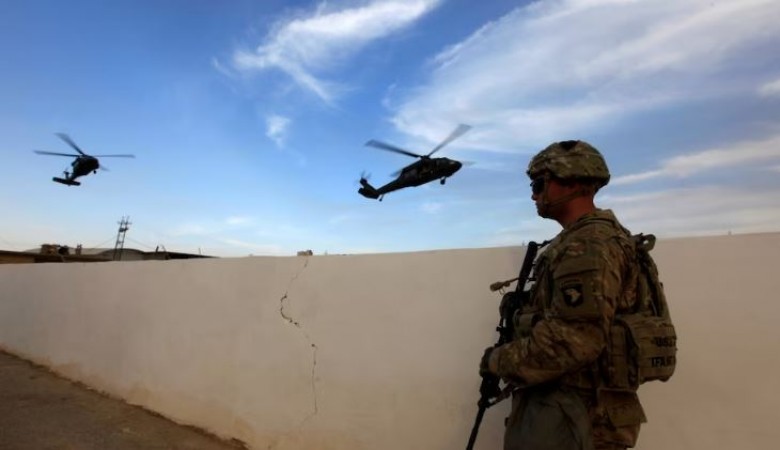
Jerusalem: Just before Israel imposed a communication blackout on Gaza and intensified its extensive assault on the Palestinian territories, the United States launched a series of airstrikes on what it referred to as Iranian "proxy" forces in Syria. These actions are part of an escalating confrontation between the U.S. and Iran, underscoring the rapid expansion of military conflict throughout the Middle East.
Late Thursday night, U.S. Defense Secretary Lloyd Austin stated, "Today, at President Biden’s direction, US military forces conducted self-defense strikes on two facilities in eastern Syria used by Iran’s Islamic Revolutionary Guard Corps (IRGC) and affiliated groups."
He continued, "Iran wants to hide its hand and deny its role in these attacks against our forces. We will not let them. If attacks by Iran’s proxies against U.S. forces continue, we will not hesitate to take further necessary measures to protect our people."
The U.S. deployed two Air Force F-16 fighters and Reaper drones to drop more than 30 bombs on what U.S. officials claimed were a weapons storage facility and an ammunition storage facility near Abu Kamal, Syria.
Austin's assertion that these strikes are "separate and distinct from the ongoing conflict between Israel and Hamas" is blatantly false. It is evident that the United States perceives Israel's offensive in Gaza as one component of a much larger military operation unfolding across the Middle East.
U.S. officials have made it clear that they will support Israel's actions, regardless of the atrocities it commits. White House National Security spokesperson John Kirby stated, "We're not drawing red lines for Israel."
Mick Mulroy, a former defense official, told the New York Times, "The U.S. sent a message tonight. We will directly respond against Iran, and specifically the IRGC, if they continue to attack our military positions and personnel in Iraq and Syria."
The White House sent Congress a war powers notice regarding the strikes on Thursday. President Biden stated, "On the night of October 26, 2023, United States forces conducted targeted strikes against facilities in eastern Syria. The precision strikes targeted facilities used by the IRGC and IRGC-affiliated groups for command and control, munitions storage, and other purposes."
Biden added, "The United States stands ready to take further action, as necessary and appropriate, to address further threats or attacks."
Following the Thursday night bombings, some sections of the U.S. political establishment demanded an even more aggressive escalation. The Wall Street Journal editorialized that "at least President Biden finally responded after more than a dozen provocations, but the Administration still isn't grappling with the root cause of the region's violence: Iran."
The Journal argued that the pinprick bombings of weapons and ammunition storage facilities are not proportionate to the enemy's attacks, pointing out that Iran's proxies have launched rockets or drones at U.S. positions at least 19 times since October 17.
The situation is rapidly escalating as the U.S. is surging ships, troops, and aircraft to the Middle East. The USS Gerald R. Ford, the most advanced U.S. aircraft carrier, has been dispatched to the Mediterranean Sea, accompanied by up to five supporting warships and 75 aircraft. The USS Dwight D. Eisenhower and its carrier battle group are heading to the Gulf of Mexico.
The U.S. already has around 30,000 military personnel stationed in the Middle East, which will be augmented by 2,000 Marines aboard vessels en route to the region. Additionally, the Pentagon announced that 900 troops are either deployed or preparing to head to the Middle East.
The U.S. has also sent dozens of aircraft and conducted nearly 100 heavy-lift aircraft missions to the region.
The Economist has speculated that American offensive action might extend beyond protecting American interests to responding to attacks on allies in the region. This uncertainty has prompted the White House to request a "contingency" plan for evacuating up to 600,000 American citizens living in Israel and Lebanon.
Meanwhile, the United Nations General Assembly voted in favor of an "immediate, durable, and sustained humanitarian truce leading to a cessation of hostilities" in Gaza. The motion passed with a vote of 120 to 14, with Israel and the United States voting against it. An amendment introduced by Canada, which aimed to condemn Hamas's incursion into Israel, failed to secure a two-thirds majority.
The U.S. military escalation across the Middle East is unfolding while Israel intensifies its military operations in Gaza. Gaza's Health Ministry recently published a list of more than 6,747 individuals killed by Israeli airstrikes. Between October 7 and 26, 7,028 Palestinians lost their lives, and 281 bodies remain unidentified.
This publication came shortly after President Biden expressed a lack of confidence in the death toll provided by Palestinian authorities. However, United Nations officials corroborated the figures presented by Palestinian authorities, emphasizing the clarity of their sourcing.
As the situation unfolds, it becomes evident that the civilian casualties are a grim consequence of this escalating conflict.
Islamic Conquest: Babylon's Transition to Iraq
Unemployment and Underemployment: Gaza's Economic Struggles
Jaishankar Calls for Regional Stability and Economic Cooperation Amid Indirect Dig at China